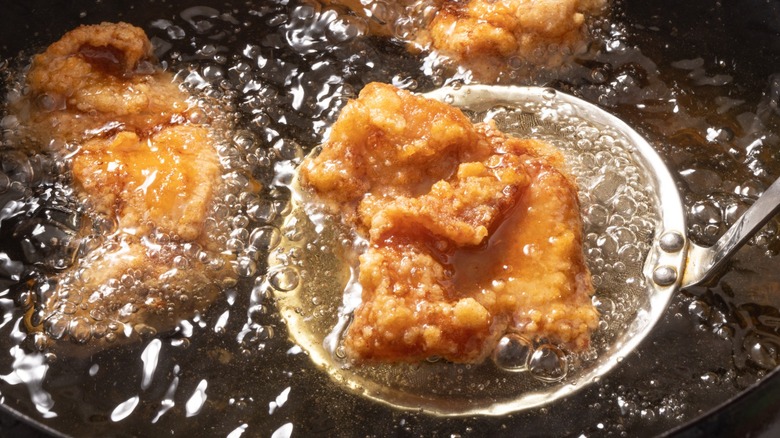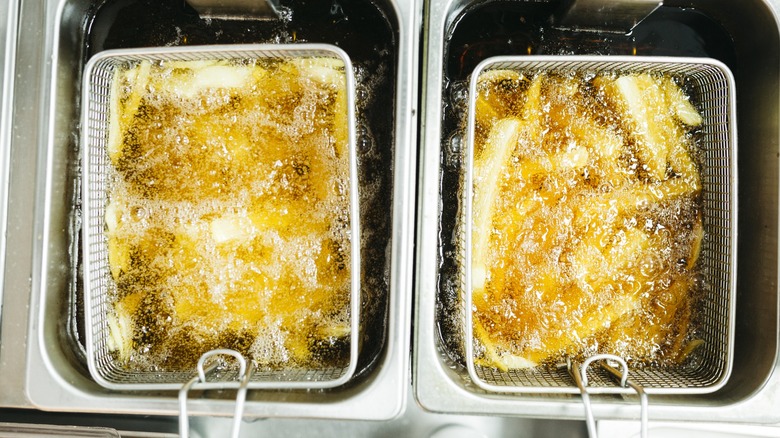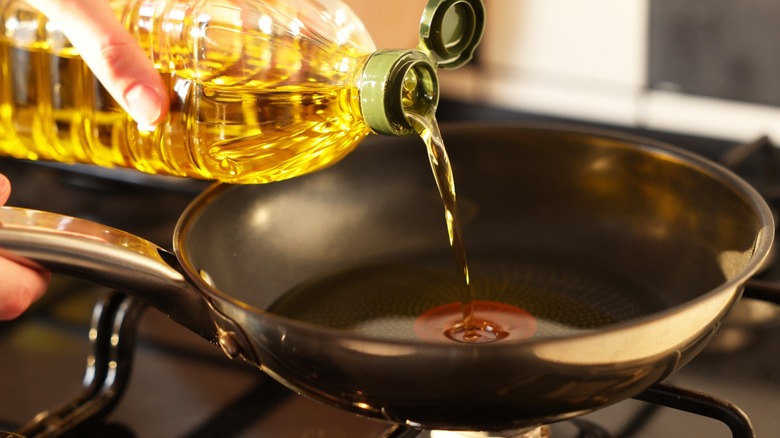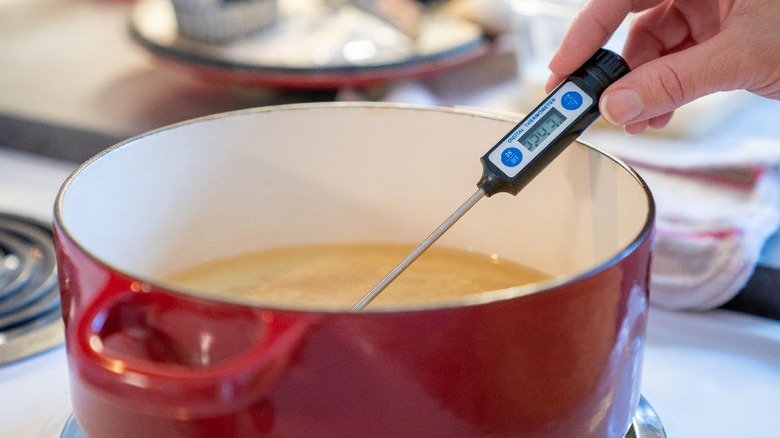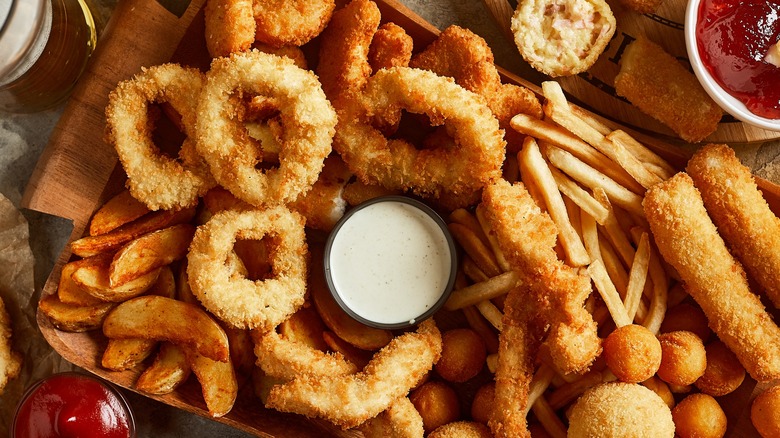What's The Real Difference Between Deep-Frying And Pan-Frying?
We may receive a commission on purchases made from links.
Frying is one of the most fundamental methods of cooking, with an instant appeal that's easy to understand. Cook food in hot oil, and it activates both the Maillard reaction or caramelization, coloring food to a beautiful golden brown. Several methods of implementing such a process exist, but the two most notable are deep-frying and pan-frying.
Even going just by the names, the methods' distinctions are easy to differentiate. To deep-fry food, you submerge it in a large vessel full of the bubbling-hot oil. Meanwhile, pan-frying is a more accessible technique, simply necessitating a thin layer of oil heated in a skillet. However, if you investigate further into the two cooking methods, more nuances appear.
With a different ratio of oil to food contact, the heat transfer behaves differently. Deep-frying is fast and efficient, using full immersion to create a crispy result. Meanwhile, pan-frying heats more from the part of the pan in contact with the food, allowing for more delicate control. However, there are also matters regarding the technology involved as well as the health benefits — a full submersion entails quite a different culinary experience, meaning it's important to understand the real difference between the two methods to let the frying shine.
What is deep frying?
When you deep-fry, you place ingredients into a generous volume of boiling oil, ensuring they're completely submerged. Wait a few minutes, and the exterior of the food starts to turn crunchy by way of dehydration. Meanwhile, the interior cooks via conduction and steam, creating a moist interior surrounded by a delectable crisp. The method's efficient, especially with large volumes of ingredients — hence its widespread popularity in fast food settings. As opposed to air, the oil-submerged environment keeps the cooking durations short, meaning there's less risk of overcooking.
However, proper cooking rests on a couple of requirements. First, it's helpful to coat the food in a starch if it doesn't already contain it — it's the external layer that dehydrates. For already starchy potatoes, that yields a crisp exterior all on its own. For meats, the lack of breading or batter just makes for a dry, tough exterior.
Additionally, controlling the oil temperature is imperative to achieving the delicate equilibrium. Too much heat, and the food burns while still raw on the interior. Fail to get the oil warm enough, and you don't get that crispy exterior fast enough to prevent too much oil from soaking into the food, running the risk of greasiness. For most foods, the sweet spot is 350 to 375 degrees Fahrenheit.
What is pan-frying?
Many home cooks are more comfortable with pan-frying solely because it feels less dangerous. You add (much less) oil to a typical skillet, creating a thin layer on the pan bottom. Then you warm the vessel to a temperature that's moderately hot but not hot enough to reach the oil's smoke point — basically, hot enough to attain a sizzle. When you add the foodstuff, the oil just barely coats the underside.
Due to the skillet's large surface area and shallow depth, this cooking method promotes even heat distribution on the surfaces in contact with the pan and oil. Generally, the technique entails as little agitation as possible. The ingredient is sizzled in sustained fashion, promoting the Maillard reaction and slowly creating a crust. But there's only heat on one side, which means you need to flip the food to cook the other. It's a method that promotes consistency, especially useful for flat and wide ingredients.
There's nuance regarding pan-frying in relation to other skillet-based cooking methods. Add a little more oil — enough to submerge the food about halfway — and the technique becomes shallow-frying. Turn up the heat, and it becomes searing. And if you involve more food movement over lower temperatures, then the method turns into sautéing.
Deep-frying requires more cooking gear
For a home cook, the culinary tools involved mark an important delineation between the methods. All you need for pan-frying is a hot skillet and some tongs or a spatula to turn the food, making it the more accessible of the two. For best results, use a hefty pan with the proper heat conduction skills. Cast iron and stainless steel lend a consistent heat transfer to ensure your food cooks evenly, though you can really use just about any skillet.
Deep-frying is a different story. Because you're using a large quantity of boiling-hot oil, it requires some specific equipment, though you may have some of it already. Start off with a heavy-duty pot. Choose a large one with a heavy bottom, deep sides, and a non-reactive coating. Enameled cast-iron jobs like the Lodge 7.5-quart Dutch oven are a popular choice. You also need a metal skimmer or strainer to retrieve food and shake off the oil and a thermometer to monitor the oil's temperature, although Rachael Ray's quick trick to tell when frying oil is hot enough can help in a pinch. You also need a cooling rack to set the food on so it can cool without grease building up.
If deep-frying catches your fancy, you can invest in an electric deep fryer like the Presto FryDaddy, which some cooks feel makes the process easier and safer. Regardless of the format, the method adds the hassle of oil disposal since you have to fill a large vessel with it. Throwing out your frying oil after one use is a huge mistake, though you eventually have to. Products like FryAway deep-fry cooking oil solidifier turn the oil into an easy-to-toss mass, but it's still an extra step.
Each method favors certain foods
Since pan frying entails minimal agitation, it shines with delicate ingredients. It's a go-to method for seafood: think frying an unbattered fish fillet, a serving of scallops, or crab cakes. Furthermore, pan-frying conveniently crafts a nice crisp on dishes like skillet potatoes, a breaded schnitzel, or a round of latkes. And don't neglect the delicious textures of a pan-fried protein: chicken thighs or pork chops shine in a bit of oil.
Deep-frying typically works best with battered or breaded ingredients; classics like fried chicken, onion rings, or battered fish and chips wouldn't be what they are without the audible crunch you get from deep-frying (though modern air fryers do get your food pretty crispy). Some cuisines have entire fried food subsections like tempura in Japan or Portuguese salgados. And ingenious chefs around the world make physically impossible creations like fried beer, fried ice cream, and fried candy bars. Plus, select dishes — like deep-fried kale or Brussels sprouts — can turn out without added starch.
